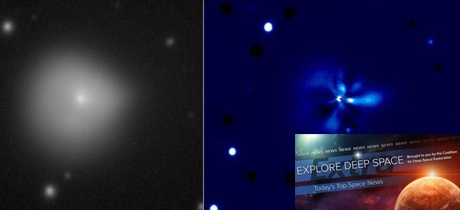In Today’s Deep Space Extra… Next flight to the International Space Station further delayed due to medical issue. NASA announces combined offices, new roles within the agency.
Human Space Exploration
Inside Artemis 1’s complex launch windows and constraints
Coalition Member in the News – United Launch Alliance
NASAspaceflight.com (11/1): Though counting on the world’s most powerful rocket, the Space Launch System (SLS), the Artemis I mission faces challenges in achieving the first flight of an Orion crew capsule around the Moon and back to Earth. Some have to do with gravitational alignments of the Earth, Moon, and sun, so the multi-week, uncrewed test flight can achieve a distant retrograde orbit at the Moon and return for a Pacific Ocean recovery in daylight. The constraints generally permit a two-week launch period followed by a two week stand down. NASA is looking to February 12-27 and March 12-27 for the Artemis I launch windows.
SpaceX’s Crew-3 astronaut launch for NASA delayed by ‘minor medical issue’
Space.com (11/1): NASA announced on Monday that the launch of the Crew-3 mission to the International Space Station (ISS) with four U.S. and European astronauts has been pushed back from November 3 to November 6 at the earliest, due to an undisclosed health concern involving one of the fliers. Without disclosing the specific health concern nor astronaut other than to state it’s not Covid-19-related, NASA characterized the issue as “minor.”
Space Science
Beresheet 2 to include two landers and an orbiter
SpaceNews.com (10/29): SpaceIL and Israel Aerospace Industries are following up the April 2019 failure of the Beresheet lunar lander with a new design and strategy. Beresheet 2 will feature an orbiter with two much smaller landers that will attempt to touch down at different sites on the Moon. The UAE space agency has an agreement with SpaceIL to provide mission instrumentation.
This mysterious comet’s super-bright outbursts has astronomers puzzled
Space.com (11/2): Comet 29P behaves in such an unpredictable way that professional astronomers don’t know what to do with it. One of the strangest comets in the solar system has been erupting with unpredictable bright outbursts since late September and nobody knows why. An international observation campaign comprising amateur and professional astronomers alike, and even the famous Hubble Space Telescope, now wants to crack the mystery.
Other News
Lal to lead new NASA Office of Technology, Policy and Strategy
Spacepolicyonline.com (11/1): NASA Administrator Bill Nelson yesterday announced the merging of two offices into the Office of Technology, Policy, and Strategy (OTPS). The new office is being established to provide data-driven technology, policy, and strategy advice to NASA leadership. OTPS is a merger of the Office of Strategic Engagements and Assessments and the Office of the Chief Technologist. Bhavya Lal will lead OTPS and report to Deputy Administrator Pam Melroy. Douglas Terrier, who was NASA’s Chief Technologist, has been reassigned to the Johnson Space Center (JSC) as Associate Director for Vision and Strategy. Tom Cremins, who was Associate Administrator for Strategic Engagements and Assessment, is now Associate Administrator for Space Security Interests. Melanie Saunders, who was Deputy Associate Administrator, will now serve as the “Chief Resilience Officer,” leading agency COVID response efforts. Casey Swails will serve as Associate Administrator Bob Cabana’s principal advisor and Deputy Associate Administrator for Business Operations.
Redwire acquires space biotech company Techshot
SpaceNews.com (11/2): Redwire announced today that it purchased Techshot, an Indiana-based company that develops biotechnology payloads for microgravity research. “As part of Redwire, we now have more of the resources we need to help accelerate the development of our growing portfolio of new space biomedical technologies, while we continue to provide great service to our research and deep space exploration customers,” John Vellinger, president of Techshot, said in a statement.
Northrop Grumman selects Mynaric as ‘strategic supplier’ of space laser communications
Coalition Member in the News – Northrop Grumman
SpaceNews.com (11/1): Mynaric, a manufacturer of laser communications equipment, announced November 1 it was selected by Northrop Grumman as a strategic supplier. The partnership with top Pentagon contractor Northrop Grumman is significant for Germany-based Mynaric, which has been making moves in the U.S. market, particularly in the government and defense sectors. “The U.S. government is the driving force to deploy laser communication capabilities in space,” Mynaric CEO Bulent Altan, said in a statement.
FAA delays spaceport decision again
New Brunswick News of Georgia (11/1): The FAA is looking to mid-December for a decision on issuing a license for a proposed spaceport in Georgia’s Camden County, the latest in a series of delays on the decision, which may be tied to opposition among some land owners and the Department of Interior regarding rocket launches over populated areas.
Diversion
Night sky, November 2021: What you can see this month
Space.com (11/2): A clear night sky offers an ever-changing display of fascinating objects to see — stars, constellations, and bright planets, often the Moon, and sometimes special events like meteor showers. Observing the night sky can be done with no special equipment, although a sky map can be very useful. Find out what’s up in the night sky (Planets Visible Now, Moon Phases, Observing Highlights This Month) plus other resources (Skywatching Terms, Night Sky Observing Tips and Further Reading)

